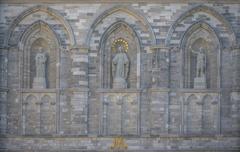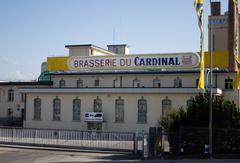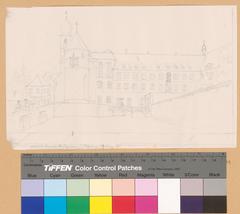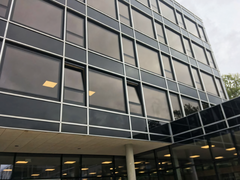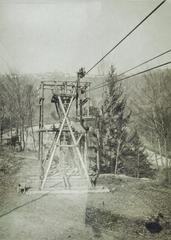Visiting Pont de la Poya: Hours, Tickets, and Nearby Historical Sites
Date: 01/08/2024
Introduction
Discover the marvel of modern engineering and historical preservation with a visit to the Pont de la Poya in Fribourg, Switzerland. Standing as the longest cable-stayed bridge in the country, the Pont de la Poya is more than just a transportation route; it is a symbol of Fribourg’s dedication to blending historical charm with contemporary infrastructure. Inaugurated on October 10, 2014, this architectural wonder spans the picturesque Sarine River, providing breathtaking views and significantly alleviating the traffic congestion that once plagued Fribourg’s historic center (Wikipedia: Pont de la Poya).
This guide aims to provide comprehensive information for visitors eager to explore this iconic landmark. From its rich history and intricate construction details to practical travel tips and nearby attractions, this article covers all aspects to ensure a memorable visit. Whether you’re an engineering enthusiast, a history buff, or simply someone looking to enjoy the stunning vistas, the Pont de la Poya offers something for everyone. Join us as we delve into the fascinating journey of this remarkable bridge and its impact on the city of Fribourg.
History and Construction of Pont de la Poya
Early Planning and Approval
The idea for a new bridge to cross the Sarine River in Fribourg dates back to 1959 when initial studies were conducted to address the increasing traffic congestion in the city. Over the following decades, numerous studies and proposals were put forward, but it wasn’t until the early 2000s that the project began to gain significant momentum. On June 23, 2006, the Grand Council of Fribourg approved the funding for the construction of the Pont de la Poya. This decision was subsequently ratified by the citizens of the canton of Fribourg on September 24, 2006, with an overwhelming 81% in favor of the project (Wikipedia).
Construction Timeline
The construction of the Pont de la Poya officially began on October 31, 2008, under the direction of Bernard Houriet and the engineering firms GVH and CP ingénieurs civils. Initially, the project was expected to be completed by 2012. However, various delays pushed the completion date to the second half of 2014. The bridge was finally inaugurated on October 10, 2014, in a ceremony attended by approximately 700 guests, including notable figures such as Doris Leuthard, the Federal Councillor responsible for the Federal Department of Transport, and Maurice Ropraz, the State Councillor of Fribourg (Wikipedia).
Design and Technical Specifications
The Pont de la Poya is a cable-stayed bridge, a design chosen for its ability to span long distances without the need for numerous piers, thus minimizing the environmental impact on the Sarine River below. The bridge measures 851 meters in length, making it the longest cable-stayed bridge in Switzerland. Its main span stretches 196 meters, supported by two pylons that rise 107 meters above the river (Bridge Info).
The bridge features three lanes for motorized traffic: two lanes heading towards the Schoenberg district and one lane towards the Route de Morat. Additionally, there is a 3.5-meter-wide mixed-use lane for cyclists and pedestrians, separated from the vehicular lanes by a metal barrier for safety. This lane connects the Bellevue intersection to the Chemin du Palatinat, providing a secure route for non-motorized users (Wikipedia).
Safety and Environmental Considerations
Safety was a paramount concern during the design and construction of the Pont de la Poya. The bridge is equipped with 2.5-meter-high mesh barriers on both sides to prevent accidents and deter suicide attempts. Despite these barriers, several small glass windows have been installed along the pedestrian and cyclist lane, allowing visitors to enjoy the scenic views of the Sarine River and the surrounding landscape (Wikipedia).
The construction of the bridge also aimed to address significant environmental issues. Prior to its completion, the city of Fribourg experienced severe traffic congestion, particularly during peak hours. This congestion not only caused frequent delays but also resulted in pollution levels that exceeded the limits set by the Swiss Ordinance on Air Pollution Control (OPair). The increased traffic and pollution were damaging the facades and ornaments of the historic Saint Nicholas Cathedral. By diverting traffic from the city center, the Pont de la Poya has helped alleviate these problems, preserving the historical and architectural heritage of Fribourg (Wikipedia).
Financial Aspects
The initial budget for the Pont de la Poya was estimated at 120 million Swiss francs. However, due to various unforeseen challenges and additional requirements, the final cost of the project escalated to 211 million Swiss francs. Despite these cost overruns, the bridge is considered a crucial infrastructure investment for the city of Fribourg, significantly improving traffic flow and reducing environmental impact (Wikipedia).
Visitor Information
Ticket Prices and Visiting Hours
Visiting the Pont de la Poya is free of charge. The bridge is accessible 24/7, allowing visitors to enjoy the stunning views both day and night.
Accessibility
The bridge is fully accessible to pedestrians, cyclists, and vehicles, making it a convenient route for all types of visitors. The mixed-use lane ensures safety for non-motorized users.
Nearby Attractions
While visiting the Pont de la Poya, consider exploring other attractions in Fribourg:
- Saint Nicholas Cathedral: A historic landmark known for its gothic architecture.
- Old Town Fribourg: Offers a charming glimpse into the city’s medieval past.
- Fribourg Museum of Art and History: Features an extensive collection of art and historical artifacts.
Travel Tips
- Best Time to Visit: Early mornings or late afternoons provide the best lighting for photography and fewer crowds.
- Photography Spots: The small glass windows along the pedestrian lane offer perfect spots for capturing the scenic views.
- Guided Tours: Consider taking a guided tour to learn more about the history and engineering marvels of the bridge.
Special Sections
Events and Guided Tours
The Pont de la Poya occasionally hosts special events and guided tours. Check the official Fribourg tourism website for the latest information on upcoming events and tour schedules.
Best Spots for Photography
The bridge offers numerous vantage points for photography. For the best shots, visit during sunrise or sunset when the lighting enhances the natural beauty of the Sarine River and the surrounding landscape.
Inauguration and Public Reception
The Pont de la Poya was officially opened to the public on October 11, 2014, with a special open day event that allowed pedestrians to explore the bridge before it was opened to vehicular traffic the following day. The public reception was overwhelmingly positive, with many residents appreciating the bridge’s modern design and the practical benefits it brought to the city’s transportation network (Wikipedia).
Impact on Local Infrastructure
The opening of the Pont de la Poya had a significant impact on the local infrastructure of Fribourg. One of the most notable changes was the closure of the Pont de Zaehringen to private vehicular traffic. This historic bridge, located upstream from the Pont de la Poya, was closed to preserve the Bourg district, which includes the Saint Nicholas Cathedral. By redirecting traffic to the new bridge, the city has been able to protect its historical sites while still accommodating modern transportation needs (Wikipedia).
Conclusion
The Pont de la Poya is more than just a bridge; it’s a symbol of Fribourg’s dedication to preserving its historical charm while embracing modern infrastructure. Plan your visit today to experience the breathtaking views and the seamless blend of past and present. Don’t forget to download our mobile app Audiala for more travel tips and follow us on social media for updates.
References
- Wikipedia contributors. (2023). Pont de la Poya. In Wikipedia, The Free Encyclopedia. Retrieved from Wikipedia
- Bridge Info. (n.d.). Pont de la Poya. Retrieved from Bridge Info
- Fribourg Tourism. (n.d.). Poya Bridge. Retrieved from Fribourg Tourism
